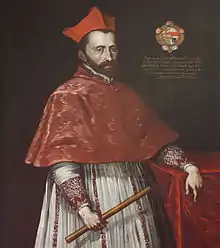Andreas von Österreich | |
|---|---|
| Margrave of Burgau Prince-Bishop of Contance Abbot of Murbach Prince-Bishop of Brixen Cardinal-Priest of Santa Maria Nuova | |
 Late 16th century portrait | |
| Church | Roman Catholic Church |
| Province | Mainz |
| Metropolis | Mainz |
| Diocese | Constance |
| Installed | 1589 |
| Term ended | 12 November 1600 |
| Other post(s) | Abbot of Murbach, Bishop of Brixen |
| Orders | |
| Created cardinal | March 1574 by Pope Gregory XIII |
| Rank | Cardinal-Priest |
| Personal details | |
| Born | 15 June 1558 Březnice Castle Březnice, Kingdom of Bohemia |
| Died | 12 November 1600 (aged 42) Rome, Papal States |
| Buried | Santa Maria dell'Anima, Rome |

Andreas von Österreich, Margrave of Burgau, also known as Andrew of Austria (15 June 1558 at Březnice Castle in Březnice, Bohemia – 12 November 1600 in Rome) was a cardinal, Bishop of Constance and of Brixen. He belonged to the Austrian nobility, descending from its ruling dynasty, the House of Habsburg.
Youth
Andrew and his younger brother Charles grew up at Bresnitz Castle in Březnice, Bohemia, and later at Ambras Castle in Innsbruck, Tyrol. The marriage of their parents, Ferdinand II, Archduke of Austria and Philippine Welser, was morganatic. This meant that the brothers were not considered members of the Habsburg dynasty and could not use their father's title, Archduke of Austria, bearing instead that of Margrave of Burgau.
His father decided that Andrew should have a career in the clergy. In March 1574, Andrew travelled to Rome, where Pope Gregory XIII made him a cardinal, with Santa Maria Nuova as his titular church. Andrew was only 17 years old, his father having obtained the position for him.[1]
Later life
Andrew was Abbot of Murbach from 1587 until his death. From 1589, he was also Bishop of Constance and from 1589 Bishop of Brixen. In 1598 and 1599, he briefly served as acting Governor General of the Habsburg Netherlands while Archduke Albert VII travelled to Spain to marry Infanta Isabella Clara Eugenia.
In 1600, he traveled to Rome to celebrate the Jubilee, afterwards visiting Naples. On his return journey, he fell ill and died after receiving the last rites from the Pope himself. He was buried in Santa Maria dell'Anima in Rome. His marble funeral monument in the church was completed by the sculptors Gillis van den Vliete and Nicolas Mostaert around 1600 and includes a portrait of Andrew kneeling in prayer.[2]
Issue
Andrew had two illegitimate children, Hans-Georg Degli Abizzi (b. 1583) and Susanna Degli Abizzi (1584–1653). They were raised by his brother Charles.
Male-line family tree
Notes
- ↑ Sigrid-Maria Größing, Leidenschaftliches Habsburg, Verlag A&M
- ↑ Tancredi Farina , Gillis van den Vliete e la comunità tedesca della chiesa di Santa Maria dell'Anima in: 'In corso d'opera 2. Ricerche dei dottorandi in Storia dell'Arte della Sapienza', a cura di C. Di Bello, R. Gandolfi, M. Latella (Collana Ricerche dei dottorandi - 2), Campisano Editore, Rome, 2019, pp. 123-130 (in Italian)
References
- Heinrich Benedikt (1957), "Burgau, Andreas", Neue Deutsche Biographie (in German), vol. 3, Berlin: Duncker & Humblot, pp. 43–44; (full text online)
- Margot Rauch: Karl von Burgau und Kardinal Andreas von Österreich, in: Philippine Welser & Anna Caterina Gonzaga: Die Gemahlinnen Erzherzog Ferdinands II., catalogue for an exhibition, Innsbruck, 1998
- Margot Rauch: Kardinal Andreas von Österreich, in: Ambras — Das Schloss der Philippine Welser, permanent presentation, Innsbruck, 2007
- Eduard Widmoser: Kardinal Andreas von Österreich, Markgraf von Burgau (1558-1600), in: Lebensbilder aus dem Bayerischen Schwaben, vol. 4, Munich, 1955, p. 249-259.
- Constantin von Wurzbach: , in: Biographisches Lexikon des Kaiserthums Oesterreich
External links
- Herbert Frey: Österreich, Andreas von in German, French and Italian in the online Historical Dictionary of Switzerland.
- Short biography